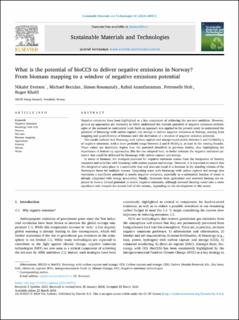| dc.contributor.author | Everson, Nikalet | |
| dc.contributor.author | Becidan, Michael | |
| dc.contributor.author | Roussanaly, Simon Nathanael | |
| dc.contributor.author | Anantharaman, Rahul | |
| dc.contributor.author | Holt, Petronelle | |
| dc.contributor.author | Khalil, Roger Antoine | |
| dc.date.accessioned | 2024-04-04T13:12:23Z | |
| dc.date.available | 2024-04-04T13:12:23Z | |
| dc.date.created | 2024-04-03T10:21:37Z | |
| dc.date.issued | 2024 | |
| dc.identifier.issn | 2214-9937 | |
| dc.identifier.uri | https://hdl.handle.net/11250/3124910 | |
| dc.description.abstract | Negative emissions have been highlighted as a key component of achieving the net-zero ambition. However, ground-up approaches are necessary to better understand the realistic potential of negative emissions technologies at the national or continental level. Such an approach was applied in the present study to understand the potential of bioenergy with carbon capture and storage to deliver negative emissions in Norway, starting from mapping and quantification of biomass until the derivation of a window of negative emission potential. The results indicate that bioenergy with carbon capture and storage could enable between 1 and 13 MtCO2/y of negative emissions, with a more probable range between 2 and 8 MtCO2/y, at least in the coming decades. These values are drastically higher than the potential identified in previous studies, thus highlighting the importance of bottom-up approaches, like the one adopted here, to better estimate the negative emissions potential that could be delivered by bioenergy with carbon capture and storage. In terms of biomass, the strongest potential for negative emissions comes from the integration of forestry resources and activities with bioenergy with carbon capture and storage. However, it is important to ensure that this integration takes place in a sustainable way and does not result in a decrease in the standing volume of the Norwegian forest for multiple reasons. Integrating waste with bioenergy with carbon capture and storage also represents a significant potential to enable negative emissions, especially as a substantial fraction of waste is already integrated with energy production. Finally, biomasses from agriculture and seaweed farming are expected to have a limited potential to enable negative emissions, although seaweed farming could take a more significant role towards the second half of the century, depending on the development of this sector. | en_US |
| dc.description.abstract | What is the potential of bioCCS to deliver negative emissions in Norway? From biomass mapping to a window of negative emissions potential | en_US |
| dc.language.iso | eng | en_US |
| dc.publisher | Elsevier | en_US |
| dc.rights | Navngivelse 4.0 Internasjonal | * |
| dc.rights.uri | http://creativecommons.org/licenses/by/4.0/deed.no | * |
| dc.title | What is the potential of bioCCS to deliver negative emissions in Norway? From biomass mapping to a window of negative emissions potential | en_US |
| dc.title.alternative | What is the potential of bioCCS to deliver negative emissions in Norway? From biomass mapping to a window of negative emissions potential | en_US |
| dc.type | Peer reviewed | en_US |
| dc.type | Journal article | en_US |
| dc.description.version | publishedVersion | en_US |
| dc.rights.holder | The Authors | en_US |
| dc.source.volume | 40 | en_US |
| dc.source.journal | Sustainable Materials and Technologies | en_US |
| dc.identifier.cristin | 2258444 | |
| dc.relation.project | Norges forskningsråd: 328715 | en_US |
| dc.source.articlenumber | e00912 | en_US |
| cristin.ispublished | true | |
| cristin.fulltext | original | |
| cristin.qualitycode | 1 | |

